 |
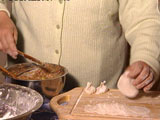 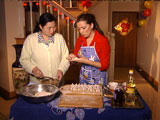 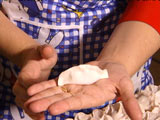 |
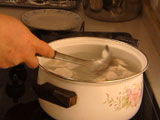 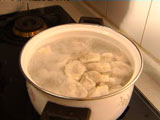  |
Story of Jiaozi(Dumpling)
Jiaozi, or dumplings with meat and vegetable fillings, is very popular at the New Year and at other festivals. It tops the list of delicacies of people in North China, where people eat jiaozi at midnight on New Year's Eve for breakfast on New Year's Day.
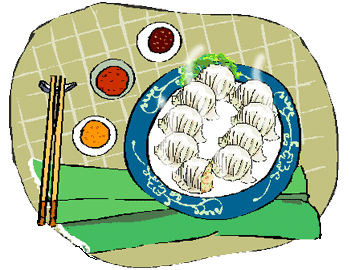
History
The history of jiaozi dates back to ancient times. But the custom of making jiaozi a special dish during the Spring Festival, or the Chinese lunar New Year, started in the Ming Dynasty, some 500 to 600 years ago.
The reason is simple. The appearance of jiaozi looks like the V-shape ( some say half- moon shaped) gold or silver ingot used as money in ancient China. As the Spring Festival marks the start of a new year, people choose to eat jiaozi to connote their wishes for good fortune in the new year.
Although time has changed, the tradition has remained. But today, jiaozi is considered more as a sign of propitious blessing than of fortune.
Jiaozi Culture
As China is a country with a vast territory, there are great differences in various regions in ways of making jiaozi or even serving it.
For example, dumpling wrappers are make with a rolling stick in most areas of Beijing and Hebei Province, whereas in some parts of Shanxi Province and Inner Mongolia Autonomous Region, wrappers are hand-pressed.
There is no set rule as to what makes dumpling fillings. They can be anything from vegetables, meat to seafood. Whatever the fillings, the wrapping skill needs to be exquisite to make jiaozi look attractive. Ways of serving jiaozi also vary from place to place.
Generally, jiaozi are boiled in clear water and served dry with vinegar, soy sauce, garlic or pepper oil if one likes them hot. In some parts of the Northeast China, however, dumplings are boiled in broth together with vermicelli made from bean starch, and served together.
People in Henan and Shanxi provinces like to boil jiaozi with noodles and serve them together. They name the serving " golden threads piercing through silver ingots,"or " silver threads stringing together calabash". Golden or silver threads mean noodles while silver threads mean noodles while silver ingots and calabash refer to jiaozi.
There are also places there people boil and serve jiaozi with sheet jell made from bean or potato starch, or with sweet dumplings, special for the Lantern Festival on the 15th of the first lunar month.
The Process of Making Jiaozi
Many families in China usually prepare enough jiaozi to last several days of the Spring Festival time. To make jiaozi, first of all, chop the meat into tiny pieces and mash them, then add salt, sesame oil, soy sauce, ginger, scallions, Chinese cabbage and MSG if you like. Mix thoroughly the ingredients and meat filling, add two spoonful of water if necessary.
In a big bowl, add water to flour gradually. (caution: not too much at a time!) Mix and knead by hand to soft dough, then cover it with towel and put it aside for about an hour.
Scatter some dry flour on the board, knead and roll it into a sausage- like dough about 5 centimeters in diameter, then chop it into small pieces. Press each piece with your hand and get a pancake. Finally, to hold the pancake with your palm and put the filling in the center and wrap it into half-moon shaped and seal the edges.
The next step is eat. Put the dumpling into boiling water, when it is well cooked, it is ready to be served. However, before eating, you need to prepare some small dishes to contain the mixture of soy sauce, vinegar, and sesame oil or pepper oil ( to suit your own taste!)
Today
Probably the fun of eating jiaozi lies not only in the delicacy itself but also in the process of preparing for it: Everybody, the host and guests alike, rolls up his sleeves and wraps the pancake to cover the filling. What great fun! Besides, it is something of great significance: the hostess is freed from the drudgery of working in the kitchen alone and can carry on a lively conversation with the guests!
As time advances, the ancient food has been continuously updated, not only in processing skills, but also in varieties, wrappers and fillings, tastes and appearances. Frozen jiaozi processed on production lines, in particular, is taking a big share of the fast food market. There have been so many varieties of jiaozi that it is no longer a rare scene for restaurants to offer a whole jiaozi banquet, serving up several dozen kinds of dumplings.
How to Cook JiaoZi (Chinese Dumplings)
Skins:
8 cups white flour
about 2 1/2 cups (very) cold water
1 teaspoon salt
Dissolve salt in water. Add 2 cups water to flour and blend THOROUGHLY. Do not add more water until it is absolutely necessary. Add remaining water as slowly as possible in order to get as hard a dough as you can. If the dough is too soft, add more flour. Knead thoroughly. Harder dough is much easier to fill. Chill while you make the filling.
Separate dough into 2 portions. Form into long sausages, about 1 inch diameter. Cut sections every 1cm. Form sections into balls and use rolling pin to form into round, flat skins about 3 inches diameter. If they are too thick, the jiaozi will be very doughy. Modify sizes of balls as appropriate.
(The other way to make skins is to buy "JiaoZi Pi" in the local Chinese store!)
Meat:
1 kilo ground meat
2 tablespoon soy sauce
2 teaspoon salt
2 teaspoon black pepper
1 teaspoon white pepper
2 teaspoon brandy or sherry or other aromatic alchohol
1 teaspoon sesame oil
Add soy sauce and salt to meat. Stir slowly, always in the same direction (if you change directions, the meat fibers don't stick together as well, and the jiaozi are more likely to fall apart when cooked). Add remaining ingredients.
Let sit while you prepare the vegetables and other additional ingredients. All need to be finely minced. Use a food processor if you have one. If you don't, I hope you have a LOT of patience. If the bits are too large, the jiaozi will fall apart.
1 inch ginger (finely minced. You can use a grater)
3-4 stalks spring onion
1 small clump fresh coriander (cilantro)
1 very small clump chives
Either: 8-10 stalks celery (at least half the entire stook). Once minced, squeeze out any excess water.
Or: 1 small head Chinese cabbage
Optional: 3 large carrots
Optional: 3-4 chinese black mushrooms (shiitake)
Optional: one fried egg
Stir them slowly into the meat mixture. For now, add only the lower numbers (eg. 8 celery, not 10). Don't let the mix get too moist.
Test scent. It should be very aromatic. If not, add a little more brandy, or sesame oil, or onion. Test consistency. Fry a teaspoon or so of the mix. It should stick together very easily. If it falls apart, it could be because (a) the mix is too dry in which case add more veggies and/or oil, or (b) because its too moist in which case add a little more meat. (Since its easier to add more veggies, that's why I suggested adding the veggies slowly!) Test flavour. (Eat the fried bit). Your entire tongue should get a little bit of life. If necessary, add a few spices to supplement -- savoury gets central tongue, white pepper the back, black pepper the front, paprika the sides.
Fiddle until you're happy.
To roll:
Take about 1 tablespoon filling and place into centre of skin. Bring one half up to meet the other half. Seal thoroughly. This usually means creating "pleats" in one half and gluing them to the other (use a tiny bit of water if you need to), If they're not well sealed, they fall apart when cooking.
To cook:
Bring large pot of water to boil. Add enough jiaozi to cover the base of the pot about 1.5 times (about 25 in a 12" diameter pot, about 50 in a good size wok). Cover.
When it comes to a boil, add 1 cup cold water. Cover. Repeat. When it comes to a boil for the third time, they are ready to serve.
Note: if you stop it before the third boil, the meat will not be cooked through. Also, if you don't add cold water each time, the jiaozi will fill up with air and explode.
Alternate cooking method:
After you've boiled them, you can fry them. This is a wonderful way to serve the leftovers, and a very common Chinese breakfast!
To serve:
Typically eaten with a sauce constructed of soy sauce, vinegar, and sugar. (ratio about 1/4 cup SS: 1/4 cup Vinegar: 1 teaspoon sugar). Also good with plain malt vinegar. To ensure that the sugar has dissolved completely, heat briefly. For more flavour, add a little sesame oil, hot oil, maggi (available in most chinese stores), and/or chilli pepper as you wish.
To store:
JiaoZi keep very well in the freezer. To freeze, place on trays so they are not touching (if they touch, they will stick together). Freeze overnight. The next day, place into plastic bags & seal. Will keep indefinitely.
|
|
|
|
|
|
|
 |









